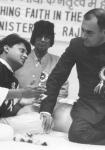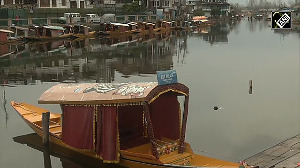Providing glimpses of the "difficulties" involved in implementation of the July 18 nuclear deal, the US has said if India did not put a "great majority" of its nuclear reactors into the civilian programme, the American Congress would think New Delhi has an agenda different from that of developing civilian nuclear industry.
Even as the two countries insist that they were working to implement the deal before President George W Bush's visit to India in March, US Ambassador David C Mulford said India's idea of separating civilian and military nuclear establishments has not so far met the "test" of credibility and "minimum standard" that would be required for the Congress to act favourably.
"The condition that has to be met for it (civil nuclear cooperation deal) to be successfully negotiated is that there has to be, what I would call, a credible separation of civil nuclear from strategic," he told PTI in an interview in New Delhi earlier this week.
Talking a week after the meeting between Foreign Secretary Shyam Saran and US Under Secretary of State Nicholas Burns on the nuclear issue after which the latter spoke about "difficulties ahead" in the negotiations, Mulford said for credibility of its plan, India must "elaborate" it.
He said India does not have to fully implement the plan, but has to commit to it. "On the basis of that commitment from India, we would seek to change the US law and we would seek to gain the consensus of the Nuclear Suppliers Group in the world -- 35 countries that control nuclear technology and fuel," the ambassador said.
"What's a credible separation plan has to be something that is sufficiently believable to members of the US Congress so that they would agree to alter the law and, in a way that would also be acceptable to the NSG of countries," Mulford said.
Though both sides are working to implement the deal before Bush's visit, the ambassador gave some indications of the complexities involved in the ongoing negotiations.
"The credibility test has to be pretty high in order to get that kind of support (in the Congress). For example, if the plan that's put forward doesn't appear to put, you know, the great majority of nuclear reactors into the civilian programme, then I think, members of the Congress are going to say, wait a minute, we thought that India wanted to develop a civil nuclear industry. So if that's the case, why are they putting so little on the civil side. They must have some different agenda," he said.
India has 22 nuclear reactors and differences persist between the two countries on the issue of how many of these should be put in the civil side so that they could be brought under IAEA inspection.
Burns, after his talks with Saran in January, had said there were "difficulties ahead" and "much more progress" was needed in the negotiations unique in nature because the US and NSG had to make India as a one-off case.
Even two days back, Burns had said in Washington that there are a "few issues" that remain "barriers".
After his talks with Burns, Saran had said, "We have come to the conclusion that we need to discuss this in greater detail in the coming days and weeks."
Noting that the US knew that India has nuclear weapons, Mulford said, "We are not doing anything about that. But we have to understand their (India's) basic industry is moving strongly into the civilian side. Otherwise, it doesn't match the game plan."
He added, "We have to deliver a credible plan and that standard has not been met yet."
Underlining that negotiating the deal was a "very complex" issue, the US Ambassador said, "(There are) lots of points to discuss and so on. But we hope we can."
Asked whether it meant the plan outlined by India at the December meeting was not credible, he said, "That didn't meet the test."






 © 2025
© 2025